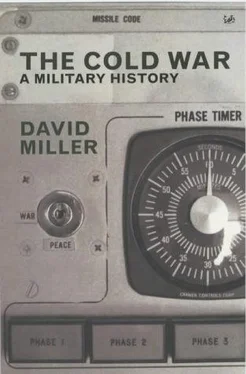Despite causing all this upheaval, the French most definitely did not leave the Atlantic Alliance, but they were highly selective as to which parts they chose to participate in. Because it remained a member of the Alliance, France took part in the meetings of the North Atlantic Council and played a full part in the Economic Committee, the Council of National Armaments Directors and the Science Committee, among other bodies. Having left the integrated military structure, it no longer participated in top-level bodies such as the Defence Planning Committee, the Military Committee and the Nuclear Planning Group, nor did it contribute to the Military Agency for Standardization or the NATO Integrated Communication System. On the other hand, it still participated in the NATO Air Defence Ground Environment and the Allied Command Europe communications system, known as ACE HIGH, and, by some curious anomaly, it continued to participate in NATO’s civil-defence programmes. The French armed forces established liaison missions with those NATO headquarters with which they might become involved in the event of war, such as Central Army Group (CENTAG) and Northern Army Group (NORTHAG).
The one task to which France remained totally committed was the occupation of Berlin and the arrangements for its defence, where it never wavered for a second in its commitment to the Allied position. It should be noted, however, that everything to do with Berlin was totally outside the NATO structure.
Some elements of the post-1966 French position were quite clear: for example, no NATO units were allowed on French soil without specific permission, nor was there any automatic Allied access to French airspace. Other areas were more ambiguous – perhaps deliberately so. France always maintained that it had total freedom of action where its nuclear forces were concerned and such co-operation as it was prepared to offer concerned only conventional forces. [1]France also maintained that the commitment of French forces could never be assumed, and that any forces committed in support of NATO allies would always remain under French command. Thus, at least in public, it was always open to question as to whether or not the First French Army, located in south-west Germany, would participate in the defence of the Federal Republic.
It was, of course, implied in the ‘no automaticity’ concept that France might have remained aloof from a European conflict, provided there was no perceived threat to French national territory or sovereignty, although this did not exclude action if the approaches to French territory were considered to be under threat. It was a matter of French policy to avoid giving explicit definitions of a variety of terms, including what could be regarded as the country’s ‘vital interests’ and the specific circumstances in which the French government would sanction the use of nuclear weapons.
Unlike the United Kingdom, the French had scarcely any domestic opposition to the possession of nuclear weapons. Even the Socialist François Mitterrand, who in earlier days was, at best, lukewarm about such weapons, became an ardent supporter once he was in power, and during his presidency he did more than any almost any of his predecessors to ensure that France’s force de dissuasion remained strong and up to date. In fact there was a remarkable national consensus on the issue of nuclear weapons, and the French Catholic bishops even published a pastoral letter, in November 1983, in which they declared that nuclear deterrence was totally consistent with the Catholic Church’s doctrine of the ‘just war’. Indeed, they went so far as to state that an argument for ‘peace at any price’ would result in a situation in which the West would not have the means to defend itself, thus effectively encouraging aggression. [2]
It is a splendid contradiction, but it was the very fact of NATO’s existence that enabled France to leave it. Had the Warsaw Pact forces been standing on the other bank of the Rhine, as was the case in 1914 and 1939, then France would perforce have had to seek allies. But the existence of West Germany and its strong buffer of NATO troops on the line of the river Elbe gave France that element of physical security that enabled it to act semi-independently. Further, by holding the Alliance at arm’s length and refusing to commit themselves, instead of being just one among fifteen or sixteen allies, the French were always treated as a special case and were constantly courted by those seeking their support. This especially applied to the question of the First French Army, where both CENTAG and NORTHAG competed for its support as a counter-attack force.
NATO proved exceptionally able to contain numerous strains between its members. The Anglo-French attack on the Suez Canal caused considerable debate within the Alliance, as some other members felt very strongly that they should have been consulted, but there were many other tensions. The traditional hostility between Greece and Turkey made their relationship in NATO difficult at the best of times, although matters became even more tense when Turkey invaded northern Cyprus in 1974. There were also numerous disputes between the two countries in the Aegean, both at sea and in the air.
The UK and Iceland were involved in a short, bitter (and ultimately pointless) fisheries dispute (known as the ‘Cod War’) in 1974.
NATO, founded as a bastion of democracy, managed to accommodate a number of military coups d’état among its members. General António Spínola led a military takeover in Portugal in 1974, while in Greece Colonel Georgios Papadopoulos seized control in 1967 and kicked out the king six months later. There was also a mutinous seizure of power by a group of French generals in Algeria in 1956, which almost led to a military coup in Paris.
NATO AND THE HUNGARIAN CRISIS
The Hungarian uprising in 1956 (see Chapter 6) inspired much vocal support in the West, especially from newspapers and American-run radio stations in Europe. This, however, was the limit of the support the Hungarians received, and when the North Atlantic Council convened in December of that year all it could say was that it had:
followed the course of events in Hungary with shock and revulsion. The brutal suppression of the heroic Hungarian people stands in stark contrast with Soviet public professions. The Council reaffirmed the conviction of its member governments that the United Nations should continue its efforts, through the pressure of world opinion, to induce the Soviets to withdraw their forces from Hungary and to right the wrongs done to the Hungarian people… {1}
In other words, NATO did nothing.
NATO AND THE CZECH CRISIS
Although NATO took certain low-level precautionary steps, the Alliance’s reactions to the 1968 Czechoslovak crisis (see Chapter 6) were again mainly vocal. Advance signals of a probable invasion were received in the West for many months before the event. In early May, Western intelligence services, using radio monitoring, aircraft equipped with long-range optical and electronic devices, and satellites, detected signs of troop concentrations on such an ominous scale that the Federal German foreign minister informed the Federal Cabinet and issued a press statement on 22 May. The Warsaw Pact troops conducted an exercise called Böhmerwald in Czechoslovakia, but Western observers then discovered that route signs leading towards the Czechoslovak border and within the country itself had been left in position, and that some of the Soviet troops taking part in the exercise had remained inside Czechoslovakia instead of leaving.
Then in late July a considerable amount of detailed information became available, reporting large troop movements in the southern part of East Germany, in southern Poland, and along those parts of Poland and the USSR bordering on Czechoslovakia. In an effort to try to discover more, USAF SR-71 Blackbird spy planes were brought in from the United States to fly along the line of the Inner German Border to observe the activity up to 100 km beyond the ‘Iron Curtain’. Another valuable intelligence source was the Allied missions to the Soviet commander-in-chief, [3]and the British mission reported on 22 July that the Soviet army’s 71st Artillery Brigade and 6 Motor Rifle Division had completely vacated their usual barracks at Bernau and that an East German army barracks at Halle was similarly empty, while on 29 July one of their patrols saw the Soviet 19 Motor Rifle Division actually deploying from its barracks. {2}
Читать дальше












